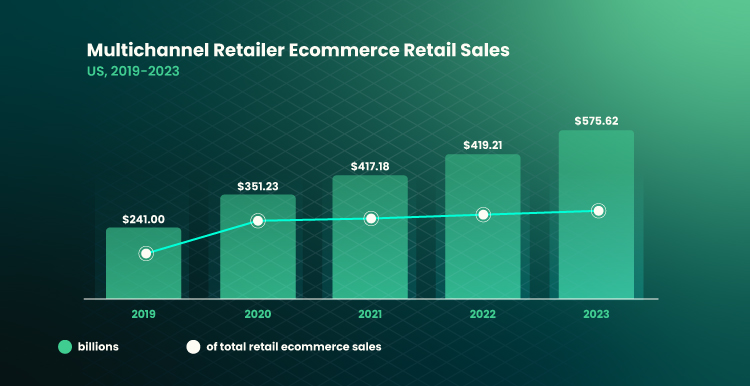The success of any online business heavily depends on its ability to accurately track website visits and the sources that bring customers in. This is why multichannel attribution is so important. It unleashes the entire customer journey by tracking each touchpoint. With detailed performance data, merchants can make informed decisions about where to invest their advertising budgets for maximum ROI.
In this article, we’ll explore the different types of multi-channel retail, multi-channel attribution models, and how they can be used to inform marketing decisions.
Multichannel Retail: Engaging Customers On- and Offline
Modern customers interact with an array of online and offline channels before committing to a purchase. From initial brand discovery to making a purchase, it’s important to be fully aware of each step along this journey and ensure you are reaching buyers at the right place, with the right message, at the right time. Multichannel retail allows brands to maximize customer engagement across multiple touchpoints, facilitating a seamless transition between physical and digital experiences.
Therefore, it is an increasingly popular method for businesses to reach a wide audience with their products and services. This strategy consists of offering merchandise on more than one platform. For example, having both an online store and physical retail locations. Many high-profile brands utilize this approach, including Amazon, Wal-Mart, Macy’s, Best Buy, Target, and Home Depot. Additionally, lesser-known companies also joined in the multichannel movement, such as individually owned boutiques, smaller department stores, and specialized dealerships.

Fostering a positive relationship between a customer and a brand across all retail channels is essential for businesses to drive sales and build customer loyalty. Through careful analysis of data gathered from customer journeys, retailers can gain useful insights into consumer behavior that will inform future marketing campaigns. To fully realize its potential, it’s up to retailers to find out how they can leverage their understanding of the multichannel buyer’s journey to maximize their returns.
Advantages of Multichannel Retailing
Shopping today is no longer confined to a physical storefront, with multichannel retailing providing access to customers anywhere, anytime. This method of retailing has revolutionized the way consumers find and purchase products, with clear advantages for both buyers and sellers:
- Increased reach: businesses can reach more potential customers, as customers may prefer using different platforms for different purposes.
- Improved customer experience: customers can choose their preferred platform and find and purchase the products they need quickly and with minimal hassle.
- Greater opportunities for cross-selling and upselling: multi-channel retailing creates more opportunities for businesses to cross-sell and upsell their products as customers can easily shop across multiple platforms and are presented with related or upgraded items that they might not have otherwise found or known about.
- Enhanced personalization: businesses can leverage data from multiple channels for better customer experience management due to deeper insights into their buying behaviors, preferences, needs, and wants.
- Possible cost savings: having an integrated platform for all channels could result in cost savings due to reduced admin costs associated with managing separate systems for each channel.
Multichannel Attribution: Understanding the Buyer’s Journey
Multi-channel attribution is an analytical framework that digital marketers use to identify which marketing channels contribute to customer conversions. It helps them better understand the consumer journey, allowing for insights and decisions that reveal the most effective mix of channels and tactics used in a campaign.
By reallocating the budget from lower-value channels to higher-value ones, multi-channel attribution enables better optimization of marketing spent across multiple channels. The insights garnered from multi-channel attribution can be used to improve effectiveness and efficiency in online marketing campaigns.
There are two types of attribution in analytics:
- Single-touch attribution: a method of analyzing customer interactions and attributing them to a single source. It can be used for marketing activities such as website visits, email campaigns, and social media campaigns and is useful when trying to get an idea of which channels are most successful in driving conversions.
- Multi-touch attribution: another method of analysis in which customer interactions are attributed to multiple sources instead of just one. This allows us to gain more insight into how our customers interact with multiple channels and can help us understand what tactics drive conversions most effectively. It helps marketers identify which channels contribute most to overall success since it measures the impact each channel has on conversions over time instead of simply looking at the first contact in isolation.
Why Multi-Channel Attribution Is Important
Multi-channel attribution models provide a detailed analysis of each touchpoint within a customer’s buying journey and how this has impacted their purchase decision, whether that be through organic search, paid search, social media, or any other online or offline channel. With this data at hand, business challenges of eCommerce stores can be solved more efficiently: retailers can make decisions about how they should invest in marketing initiatives, as well as optimize their campaigns across multiple channels.
Multi-channel attribution also enables eCommerce stores to measure ROI more accurately compared to single-channel attribution models, as it takes into account all of the touchpoints within a buyer’s journey before a purchase is made. By utilizing multi-channel attribution methods such as first click, last click, or time decay, eCommerce stores can identify which marketing activities have had the greatest impact on sales conversion rates and make informed decisions about where they should reallocate budgets in order to maximize profits from each campaign.
Multichannel Attribution Modeling
Multi-channel attribution models are used to better understand how different marketing channels and methods, such as emails, display ads, and social media posts, contribute to conversions.
There are five main types of multi-channel attribution models:
First-Touch Attribution Model
This model assigns all credit for a conversion to the first channel that introduced a customer to your business. It’s often used by marketers who want to focus on top-of-funnel activities like brand awareness or those who have limited data and need an easy way to attribute conversions. However, this model is limited in that it doesn’t account for any interactions with other channels throughout the customer journey, so it may not provide an accurate view of what’s actually driving conversions.
Last-Touch Attribution Model
This model gives full credit for a conversion to the last channel a customer interacted with before converting. This model is useful for understanding which channels are driving direct response, but it ignores any other channels that may have indirectly influenced the conversion. As such, it may not provide an accurate picture of how multiple channels worked together throughout the customer journey.
Linear Attribution Model
With a linear attribution model, all channels that were part of the customer journey are given equal credit for a conversion. This can help marketers get a better understanding of how multiple channels work together throughout the purchase process. However, it also tends to overinflate performance since every touchpoint gets equal credit regardless of its influence on conversion rates.
Time Decay Attribution Model
The time decay attribution model assigns more weight to touchpoints that occur closer in time to when the conversion takes place than those further away in time from when the conversion happened. This helps marketers understand which channels had more influence in getting customers closer to converting while still taking into account earlier touchpoints along the customer journey, which may have helped move them further down their path toward purchase.
Position-Based Attribution Model
A position-based attribution model assigns 40% credit for a conversion to both the first and last touchpoints along a customer’s journey, then splits up the remaining 20% among any middle touchpoints equally. This allows marketers to take into account both top and bottom funnel activities and influencers throughout the entire purchasing process without overinflating performance metrics for those middle touchpoints too much if there were many involved between two critical points along their customer’s journey.
Getting Started with Multichannel Attribution
Taking the first steps toward multi-channel attribution can be daunting. However, the rewards that come with taking a more holistic approach to measuring performance far outweigh this. Establishing a unified view of how your digital channels work together in driving marketing leads or sales is essential, as it allows you to make informed decisions on where resources and budgets should be allocated across all aspects of your marketing stack.
Take these three simple steps to a multichannel approach:
1. Choose your attribution model
The first step to setting up your custom attribution model is choosing the right style of attribution for your particular business. It’s important to consider the goals of your organization and how you want to measure the performance of different marketing channels in order to determine which type of attribution model is most suitable for your needs. Common types of attribution models include last touch attribution (which gives credit for conversions only to the last channel touched before a conversion occurs), linear attribution (which gives equal credit to all touchpoints throughout the customer journey), and time decay attribution (which weights the touchpoints closest in time to conversion higher than more distant ones).
2. Configure analytics
After you have decided on an attribution model, it’s time to configure your analytics platform so that it can accurately track data related to each channel involved in the customer journey. This involves making sure that all website and app event tracking is properly set up with UTM tags, as well as setting up cross-device tracking and tracking pixels or other third-party tools where necessary. Additionally, suppose you’re using an advanced web analytics platform such as Google Analytics or Adobe Analytics. In that case, it may be possible for you to customize your own unique attribution model within those platforms and change settings accordingly.
3. Test and analyze your data
The last step in setting up a custom attribution model is testing and analyzing your data. Once everything has been configured, it’s time to start measuring results across all channels involved in the customer journey and compare them against each other according to the chosen attribution model. This will allow you to identify which channels are driving more conversions or higher-value customers, giving you valuable insight into where best to focus future efforts. You should also look out for any discrepancies between expected results and actual outcomes since this could indicate technical issues with your implementation or problems with data accuracy due to poor tracking setup.
Final Word
Understanding the buyer’s journey is essential for any business engaging in multichannel retail. By taking the time to understand how customers navigate their shopping experience across multiple channels, businesses can effectively connect with and better serve their customers. Paying attention to review data, traffic sources, web analytics, and content strategies can help businesses optimize each channel while tracking customer engagement throughout their journey. This allows businesses to pinpoint potential issues and refine processes accordingly.
Want to improve your business strategy? Or, perhaps, you need a reliable custom software development company? Forbytes is at your service. We help companies across the globe create innovative digital products and stand among their competitors.
Contact us today and let’s move into the future together.

Our Engineers
Can Help
Are you ready to discover all benefits of running a business in the digital era?

Our Engineers
Can Help
Are you ready to discover all benefits of running a business in the digital era?







